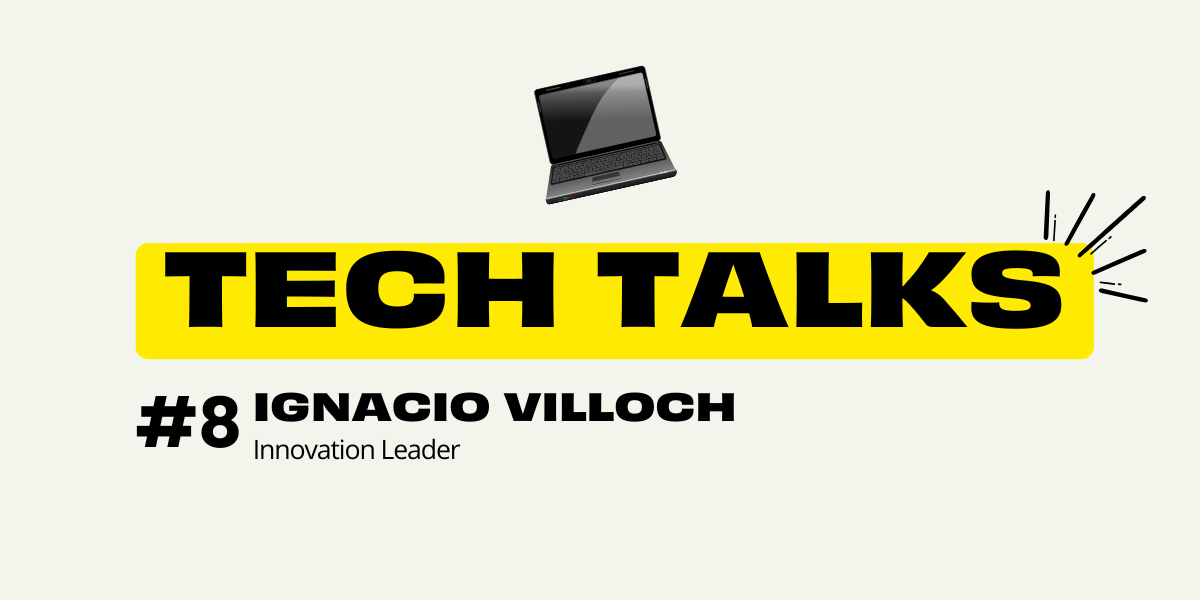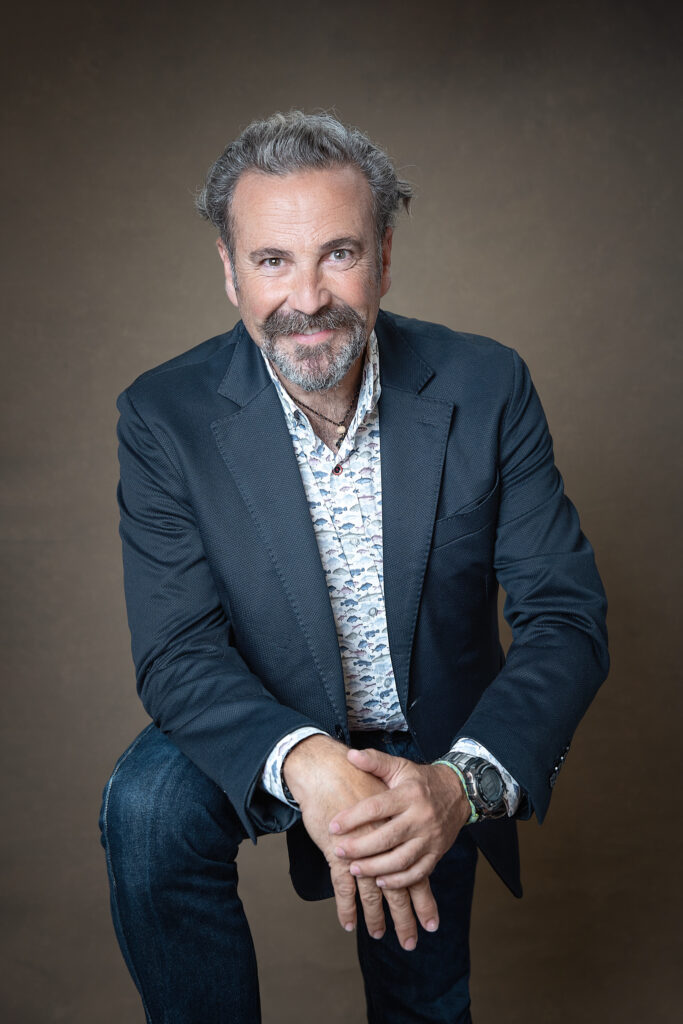
Unlocking Innovation: A Conversation with Nacho Villoch

Ignacio “Nacho” Villoch has spent his career at the intersection of innovation, storytelling, and strategy – helping big ideas take shape inside banks, startups, and global organizations. As a seasoned innovation evangelist and connector of unlikely dots, he knows how disruptive thinking really happens and what keeps it from happening. In this conversation, he shares why storytelling is the secret weapon of change-makers, how innovation cultures are built (or broken), and what leaders can do to stop blocking the future before it starts.
Hello Nacho, thank you for being with us and for sharing your experience in our 8th edition of Talent-R Tech Talks. We know you’ve seen firsthand how innovation is driving change across industries today, so let’s start with a broad perspective: From your perspective, what qualities define impactful leadership in today’s fast-evolving tech landscape?
“The qualities that define leaders in today’s rapidly changing technological landscape are: Innovative vision, such as the ability to anticipate trends and potential disruptions before they occur, ambidexterity, or the ability to simultaneously exploit – or optimizing the use of available resources- and explore other alternatives.
Adaptability and flexibility to adapt to change- technological, regulatory, market, etc, identifying potential opportunities without falling into analysis paralysis. Certain up-to-date technological skills, at least to understand technological convergence and the power of digitalization and exponential technologies as a potential solution, as well as the implications of cybersecurity. Sensitivity to the challenges of sustainability (ESG), diversity and inclusion, and CSR. Advanced and effective communication skills to inspire, excite, and connect with all stakeholders.”
“Only optimists, those who believe the future is better, do their best to build it and make it happen.”
Having witnessed digital transformation across multiple sectors, what are the most common barriers organizations face, and how can they overcome them?
“The barriers to innovation- Transformation- are perfectly diagnosed and easily identifiable… what’s more difficult is eliminating them. Among the most common barriers are:
Cultural transformation-thinking that digital transformation, because of the “digital” term, corresponds to the IT department; it’s really a cultural transformation of values, beliefs, behaviors, and attitudes, and that requires exemplary leadership. It’s not enough to take off the necktie and dress casually. This change in behaviors, barriers, and attitudes often involves breaking the inertia of “because it’s always been done that way” and freeing oneself from the “shackles of legacy”… and reviewing and even discarding some outdated policy and procedure manuals. You may very likely, encounter resistance to change.
A flawed incentive scheme, rewarding certain, secure, measurable, and predictable results in the short term, rather than experimentation (innovation and risk-taking in the medium term); Too much exploitation and too little exploration… beyond the horizon of quarterly results:
An obsession with control that leads to micromanagement and a lack of delegation within teams; A fear of failure that leads to paralysis through analysis; With a culture of experimentation, failures disappear and become unexpected results, and sources of learning, on “how not to do it next time”. This generates labyrinths of internal bureaucracies between organizational silos, committees that become a Bermuda Triangle in which those projects that “don’t fit into Business as Usual” disappear or are diluted.”

How important is organizational culture in ensuring that digital transformation efforts succeed? What internal shifts have you seen that can make the biggest difference?
“Cultural change is critical; Quoting the management guru Peter Drucker “ Culture eats strategy for breakfast” For example, embracing “intrapreneurship” and implementing intrapreneurial dynamics, behaviors, beliefs, values, and entrepreneurial attitudes… a sense of ownership in the project, Agile ceremonies, scrums, small, self-sufficient teams focused on delivering value in weekly or biweekly sprints. Trusting the teams, training them properly, and allowing them room to grow professionally. There’s only one thing worse than training your teams and having them leave for the competition; it’s not training them and having them stay. If you think training is expensive… try ignorance.
I’m a big fan of “brand ambassador” programs, to make visible the behaviors and attitudes of ordinary people who do extraordinary things—beyond the “employee of the month.” and that make visible those who have left their comfort zone, who have walked the extra mile, who have skipped the procedure to truly put the customer at the center.”
With your global experience, what differences or similarities have you noticed in how regions approach tech innovation and developing talent?
“Indeed, there are big “tactical” differences in the way we work; Europe regulates – Plays to protect acquired rights and a “welfare state” that they feel is threatened; Japan is very interesting; it innovates without being innovative. It produces innovative results with a culture of zero tolerance for error or creativity, or for challenging the status quo that we associate with innovation. However, they have optimized the process and overall quality at every step of the value chain, and procedurally harmonized each continuous improvement. The Nordics have made complexity simple, with very clear ESG sustainability criteria. Latinos place a lot of emphasis on personal relationships, which sometimes conflict with more rational business decisions. I follow with great interest the frugal innovations of India and Africa, with an appetite for building a better future, and ready to do leap-frogs in order to catch up the slow paced WASP world.
As for the similarities… in the end, it is people who make the difference; they need a framework for action, a defined objective, and incentives, purpose, values, and criteria to act and face unexpected scenarios..
When you look at tech teams or startups that really stand out, what qualities or practices do they share?
“Confidence and autonomy; they are empowered to act aligned with a clear purpose… sometimes a very ambitious MTP – Massive Transformative Purpose of the exponential organizations. Execution- they get things done, they make an impact, not just PowerPoints and accountability Excel spreadsheets. Focus on delivery, on creating value for their users and customers… not on selling the idea to investors. Better done than perfect. embrace Agile, lean methodologies..”
In your article “Tecnología Digital y Abundancia Exponencial,” you talk about how digital technologies create exponential abundance by multiplying resources and opportunities. How do you see this shaping the future of innovation, particularly in sectors focused on sustainability and social impact?
“I do my best to be a “Technological Optimist,” although sometimes the evidence insists otherwise, and specifically, we are feeling “westerly winds” against sustainability and social impact. I follow the thinking and am very much aligned with the thesis of Peter Diamandis and Raymond Kurzweil, founders of Singularity University: Technology has always generated abundance, and exponential technologies have the potential to generate exponential abundance. Clemente expresses this with AI and its universal democratization. They are authentic game changers. We have reached and far surpassed the “limits of the planet” – and the day of overcapacity is being reached earlier every day. When you understand the effect of Moore’s Law on digitalization and its derivatives in dematerialization, demonetization, and democratization… combined with the technological convergence of NBIC (Nano, Bio, Info Cogno) – atoms, cells, bytes, and neurons -… for example, in Digital Twins, and biotechnology makes possible something that, until recently, was science fiction.”
You’ve worked at the intersection of storytelling and innovation. How can tech professionals better communicate the value and impact of their work?
“Storytelling, from a neuroscientific point of view, engages and activates mirror neurons. According to Eduardo Galeano, “We are not made of atoms or cells, we are made of stories.” Beyond ratios and statistics, any tech professional should incorporate storytelling dynamics to excite and engage their stakeholders, clients, teams, investors… There are universal stories—plots—that resonate in our consciences and convey values we empathize with. Examples such as the Hero’s Journey, from rags to riches, defeating the monster, the search… can be perfectly applied to the narratives of Google, Facebook, Apple, Amazon, or blockchain, and most of the startup projects.”
Finally, in your view, how can tech leaders balance the drive for rapid innovation with long-term values like ethics and sustainability?
“With infinite curiosity and optimism. Only optimists, those who believe the future is better, do their best to build it and make it happen; and curiosity, to always be alert to what lies ahead, the adventure, beyond the horizon.These long-term values should serve to calibrate the internal compass and correct any external variations and deviations; every navigator knows the formula to correct these effects, as well as compensate for depression and drift.Quoting Seneca, the Andalusian philosopher of 2,000 years ago, “for the sailor who knows his course, all the winds are favorable.”



